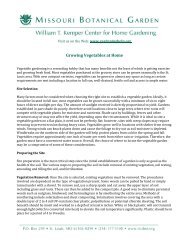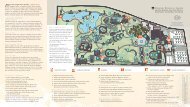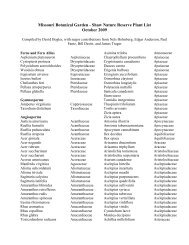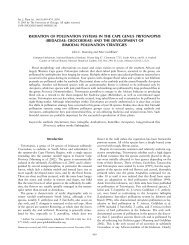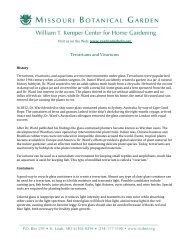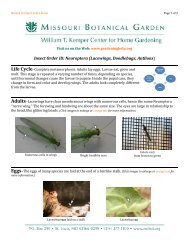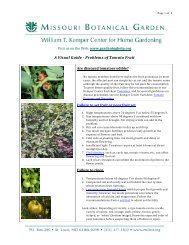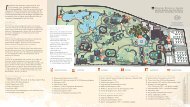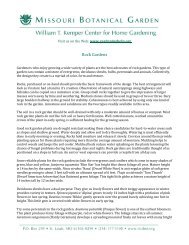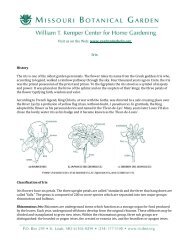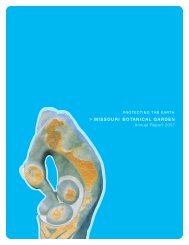2009 Annual Report - Missouri Botanical Garden
2009 Annual Report - Missouri Botanical Garden
2009 Annual Report - Missouri Botanical Garden
You also want an ePaper? Increase the reach of your titles
YUMPU automatically turns print PDFs into web optimized ePapers that Google loves.
“To all classes of society, the old and the<br />
young…a garden may be considered an object<br />
of interest and of instruction.”<br />
–Henry Shaw, A Guide to the <strong>Missouri</strong> <strong>Botanical</strong> <strong>Garden</strong> (1885)<br />
In <strong>2009</strong> <strong>Garden</strong> educators invited the<br />
public to experience EarthWays: Living the<br />
Green Life in the Brookings Interpretive<br />
Center. Created and sponsored by Maritz,<br />
this hugely popular interactive exhibit<br />
explored technology and ideas for sustainable<br />
living. Visitors took a virtual ride through<br />
winding trails and became a “power plant,”<br />
generating their own electricity.<br />
The first-ever Power of Plants contest drew<br />
hundreds of entries. The contest challenged<br />
individuals and groups in kindergarten<br />
through grade 12 to creatively tell the story<br />
of an amazing plant “superhero” through<br />
a two- or three-dimensional work of art.<br />
The grand prize winner, Lauren Epley<br />
from St. Francis of Assisi Middle School in<br />
St. Louis, won a $1,000 savings bond for her<br />
innovative presentation on the vanilla bean<br />
plant. Her winning entry inspired the plant<br />
superhero mascot for the <strong>2009</strong>–2010 contest.<br />
In <strong>2009</strong>, Science Alliance—a Boeingsupported<br />
collaboration between the<br />
<strong>Garden</strong>, St. Louis Zoo, and St. Louis Science<br />
Center—helped Mullanphy Elementary<br />
School increase its rate of teachers applying<br />
inquiry-based strategies, increase its student<br />
scores in (and enthusiasm for) science, and<br />
involve a greater number of families.<br />
At the Litzsinger Road Ecology Center, a<br />
private educational and research facility in<br />
Ladue managed by the <strong>Garden</strong>, students<br />
learn to be ecological guardians of their own<br />
schoolyard or local park. Projects such as<br />
replacing invasive plants with native species,<br />
or stabilizing a stream bank with vegetation,<br />
set the next generation on a course toward<br />
sustainability. In <strong>2009</strong>, with support from<br />
the National Science Foundation, Litzsinger<br />
staff worked with the Massachusetts Institute<br />
of Technology to pilot a program with area<br />
schools in which students use handheld<br />
computers equipped with Global Positioning<br />
System receivers to solve environmental<br />
mysteries set in their local parks.<br />
Students from<br />
area high schools<br />
also participated<br />
in field<br />
experiences in<br />
<strong>Missouri</strong> ecology,<br />
biodiversity,<br />
restoration, and<br />
protection of<br />
natural habitat<br />
as part of the<br />
Shaw Institute<br />
for Field Training<br />
(SIFT) at the<br />
Shaw Nature<br />
Reserve. SIFT<br />
is a partnership<br />
between Washington University’s Tyson<br />
Research Center and the Reserve funded by<br />
a five-year grant from the National Science<br />
Foundation. Students also participated in<br />
a monarch migration study by tagging six<br />
butterflies. This spring, they were delighted<br />
when one of the tagged monarchs was<br />
recovered in El Rosario, Mexico!<br />
The Nature Explore Classroom at the<br />
Shaw Nature Reserve celebrated its first<br />
anniversary in <strong>2009</strong>, while the Nature<br />
Explore Classroom at the <strong>Garden</strong> turned<br />
two in June. Developed by the Arbor Day<br />
Foundation as a response to the growing<br />
disconnect between children and nature,<br />
these spaces feature hands-on activities using<br />
natural materials in creative ways. The<br />
<strong>Garden</strong> was the first botanical garden in<br />
the nation to incorporate a certified Nature<br />
Explore Classroom on its grounds.<br />
Shaw imagined a place of learning at his<br />
<strong>Garden</strong>. Little did he imagine how far beyond<br />
his original efforts the <strong>Garden</strong>’s education<br />
initiatives would reach 150 years later.<br />
Students and instructors from<br />
the School of <strong>Garden</strong>ing pose<br />
on the steps of Tower Grove<br />
House at graduation, 1917.<br />
www.mobot.org 13



